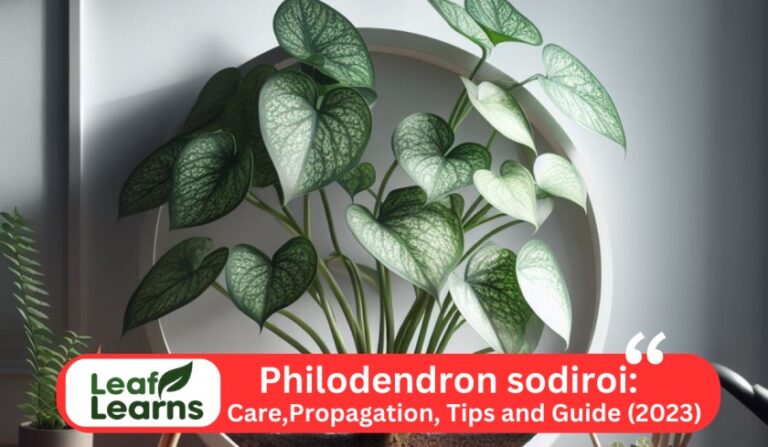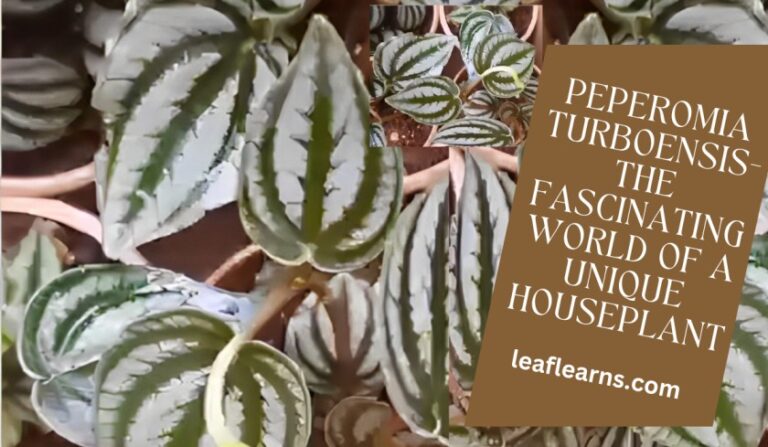Philodendron Melanochrysum Care, Grow, and Guide (2023)
The Black-gold philodendron also called Philodendron Melanochrysum. It is belongs to the Araceae family. This plant originate from Central and South America places. This beautiful plant can grow up to 3 feet in height large,having heart-shaped, and leaves show the dark green colour measuring 12-24 inches in length.
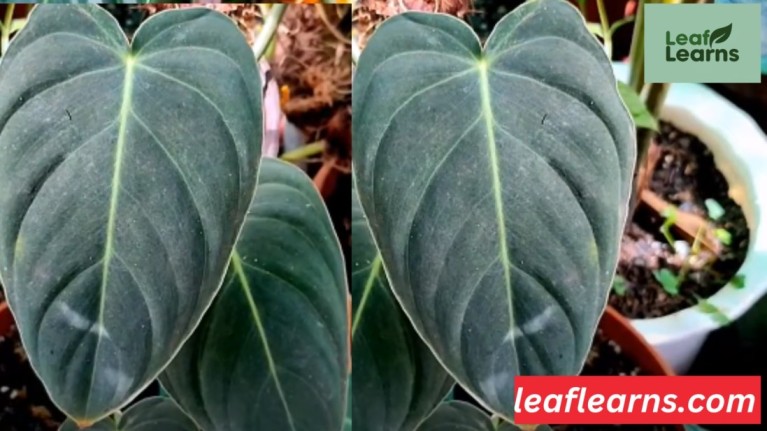
For best growth Philodendron Melanochrysum Needs bright, indirect light but not too much exceed light and it can takes high humidity Like more than 60%. This amazing plant ask to need an ideal temperature range between 65-80°F (18-27°C). For the best growing of this blushing plant can take fertilizer once in a month during the growing season and used well draining soil mix.
This plant can take the two important methods for their propagation including stem cutting and air layering. Therefore its important to note that the Black-gold philodendron is toxic to both pets and humans if ingested and it is very susceptible to pests like aphids and mealybugs, as well as root rot.
If you want a complete grow you provided the support to stem for proper growing. This Tropical plant used as an indoor ornamental plant, in hanging baskets, or on trellises and Its blooms during the summer.
| Common Name | Black-gold philodendron, melano plant |
| Scientific Name | Philodendron-Melanochrysum |
| Family | Araceae |
| Origin | Central and South America |
| Mature Size | Up to 3 feet (90 cm) in height |
| Foliage | Large, heart-shaped, dark green leaves |
| Leaf Size | 12-24 inches (30-60 cm) in length |
| Light Requirements | Bright, indirect light |
| Watering | Keep soil consistently moist, but not soggy |
| Humidity | High humidity preferred |
| Temperature | 65-80°F (18-27°C) |
| Soil Type | Well-draining, aerated soil mix |
| Fertilization | Monthly during the growing season |
| Propagation | Stem cuttings or air layering |
| Toxicity | Toxic to pets and humans if ingested |
| Pest and Disease | Susceptible to aphids, mealybugs, and root rot |
| Special Care | Requires support for climbing as it grows |
| Common Uses | Indoor ornamental plant, hanging basket, or trellis |
| Growth Rate | Moderate |
| Bloom Time | Summer |
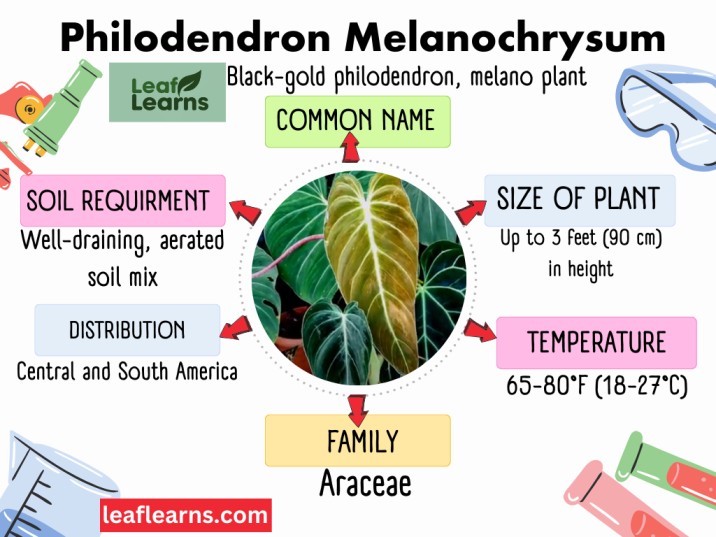
Contents
- 1 Top Care Tips
- 2 Care for philodendron melanochrysum
- 3 Pruning
- 4 Growth Rate and Size
- 5 Propagating Philodendron Melanochrysum
- 6 How to Grow Black-gold philodendron From Seed
- 7 Repotting for Philodendron-Melanochrysum
- 8 Flowering and Foliage
- 9 Overwintering
- 10 Common Pests
- 11 Plant Diseases
- 12 How to Get Black-gold philodendron to Bloom
- 13 Problems and Solutions
- 14 Toxicity
- 15 Philodendron melanochrysum Appearance
- 16 Suggested Uses
- 17 Creating the Ideal Environment
- 18 Propagation and Pruning Techniques
- 19 Conclusion
- 20 FAQs
Top Care Tips
Put your Philodendron-Melanochrysum in a location that receives strong light, but not direct sunshine. The leaves might suffer from too much sun.
Watering: Consistently mist the soil, but don’t drown it. Before you rehydrate the soil, allow the top inch of it to dry off. Water it less frequently in the winter, when it grows less.
This plant enjoys high humidity levels. Use a humidifier, put a tray of wet pebbles nearby, or give the plant a frequent spray of water to make it happy.
Feed your plant with a balanced liquid fertiliser once a month in the spring and summer. During the winter, when it isn’t growing as much, avoid feeding it.
Supporting Growth: Because this plant enjoys climbing, provide it with a moss pole or trellis for it to do so. As it develops, keep an eye on it to make sure it has appropriate support.
Care for philodendron melanochrysum
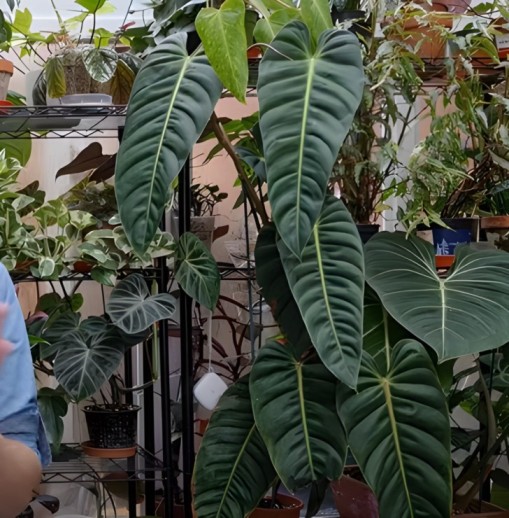
Light Requirement
Bright, indirect sunshine is ideal for Black-gold philodendron growth. Stay out of the direct, hot sun since it will burn the leaves.
Put your plant close to a window that receives filtered light, or use thin curtains to soften the light. Ample lighting guarantees strong growth and colourful foliage.
Water Requirement
Always keep the soil wet, but not waterlogged. When you can touch the top inch of dirt, it’s time to water. Assemble drainage holes in your pot to avoid waterlogging, which can cause root damage.
Avoid letting the plant stay in standing water and only use water that is room temperature.
Soil Requirement
To give your Philodendron-Melanochrysum a healthy habitat, use well-draining soil. Pine bark, perlite, and peat moss are good combinations.
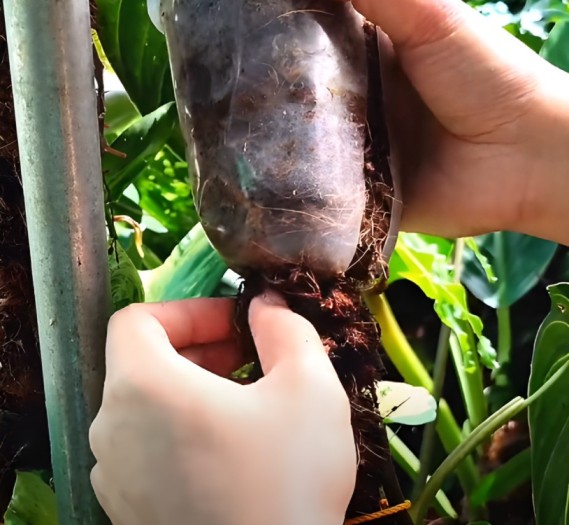
In order to prevent root suffocation, this mixture encourages optimum aeration and moisture retention. For additional nutrients, make sure the potting mix is high in organic matter.
As your plant grows, repot it to keep its roots from getting entangled.
Temperature Requirement
For your Philodendron-Melanochrysum, maintain a comfortable temperature range of 65–80°F (18–27°C). Keep it away from chilly draughts since they might harm the plant.
Additionally, sudden temperature changes have to be avoided. Maintain a steady, warm atmosphere for your plant to promote healthy development and minimise stress.
Humidity Requirement
For Black-gold philodendron, high humidity is essential; aim for 60% or greater. To do this, spritz the plant frequently, use a humidity tray, or put a humidifier close by.
The leaves remain lush and avoid drying out or developing brown edges thanks to enough humidity.
Potting Requirement
To stop water from collecting at the bottom of the pot, choose a well-draining pot with drainage holes. This helps prevent root rot brought on by wet soil.
Make sure the pot is the right size and has ample area for expansion. When your Black-gold philodendron outgrows its pot, which typically happens every 1-2 years, repotte it.
When repotting, use new, well-draining potting soil to provide the plant the nutrients and room it requires to flourish.
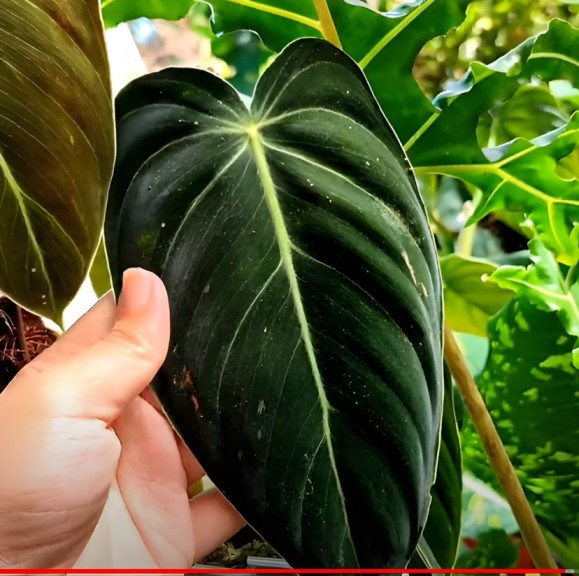
Pruning
Trim any brown, yellow, or dead leaves at their bases to remove them. This assists the plant in concentrating its energy on new development.
Trim Leggy Stems: Trim the longer stems to promote bushier growth if your plant becomes too leggy (long and sparse).
trimmed Just Above Leaf Nodes: Just above a leaf node, or the hump where a leaf develops, is where stems should be trimmed. This encourages new growth to start there.
Regular Maintenance: Check for overgrown or unruly stems on a regular basis and trim as necessary.
Growth Rate and Size
The Philodendron-Melanochrysum grows slowly but steadily, so don’t expect it to suddenly take off but rather to develop gradually over time. You may anticipate it to reach a height of 2-4 feet in ideal circumstances, with a comparable spread.
It is a stunning addition to any indoor garden due to the length of its rich, velvety leaves, which may become up to 12 inches long.
Remember that this plant requires patience because it grows slowly, which adds to its beauty and makes it grow to a lovely and manageable size over time.
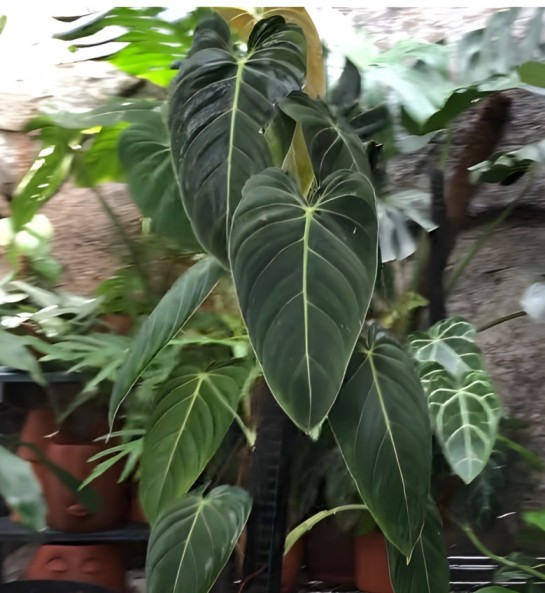
Propagating Philodendron Melanochrysum
Stem Cuttings
- A healthy stem with at least two nodes—the places where leaves and roots grow—is best for cuttings.
- Making a clean cut: Just below a node, make a clean cut using clean, sharp scissors or pruning shears. 4-6 inches is the perfect cutting length.
- To prevent rotting, let the cut end callus and dry for many hours or overnight.
- Planting: Place the cutting in a little container with some potting soil that drains nicely. Water it sparingly.
- Creating Humidity: To produce a mini-greenhouse effect, cover the cutting with a plastic bag or a clear plastic dome.
- Place the pot in a place with indirect light; stay away from direct sunshine.
Air Layering
- Picking a Branch: On the parent plant, pick a strong, mature branch.
- Making a short, diagonal cut on the branch’s bottom side will prepare it for dusting with rooting hormone.
- Cover with Moist Moss: Sphagnum moss wrapped around the incision and covered with foil or plastic wrap.
- Moss Securing: Use plastic ties or thread to hold the moss in place.
- Maintain Moisture: Within a few months, roots will begin to grow if you keep the moss continually moist.
- Cutting and transplanting: After the branch’s roots have taken hold, cut it below the rooted portion and place it in a container.
Division
- Choose a Mature Plant: Select a mature Black-gold philodendron that has multiple stems.
- Remove from Pot: Carefully remove the plant from its pot, being mindful not to damage the roots.
- Separate Stems: Gently separate the plant into sections, ensuring that each section has roots and stems.
- Plant Separated Sections: Plant each separated section in its own pot with fresh potting mix.
- Watering: Water each newly potted section thoroughly.
How to Grow Black-gold philodendron From Seed
Harvest ripe seeds from the fruit of your plant for seed collection. They resemble tiny, brown seeds.
Fill a seed dish with potting soil that drains properly. Be sure to lightly moisten the mixture.
Planting Seeds: Spread the seeds apart and gently push them into the soil’s surface.
Cover Lightly: Lightly cover the seeds with dirt, but don’t bury them too deeply.
Maintain a steady moisture level in the soil while limiting humidity to prevent waterlogging. To maintain a high humidity level, cover the tray with plastic.
Place the tray in a location with indirect light. Stay out of the sun.
Be patient; germination might take a few weeks.
When seedlings are a few inches tall, transplant them into separate pots using the usual Philodendron care. Enjoy seeing them develop!
Repotting for Philodendron-Melanochrysum
When your Black-gold philodendron grows too large for its present pot, repotting it is like giving it a new home. When you see that it is becoming congested or that the soil is not draining properly, you should take this action.
This is how: Locate a little bigger container with drainage holes and fill it with new, permeable soil. Remove the plant from its previous container with care, slightly loosen the roots, and then set it in the new one.
Make sure the plant is at the same depth as previously and fill the remaining space with dirt. After a little watering, you’re done! As a result, your philodendron has more room to expand and is kept happy and healthy.
Flowering and Foliage
More so than its blooms, the Philodendron-melanochrysum is well-known for its breathtaking leaves. Large, heart-shaped, and rich, dark green in colour, its leaves provide an air of grandeur to any space.
It doesn’t have a reputation for having large, showy flowers, but when it does bloom, you might notice them. But what really steals the show and makes this plant a favourite among indoor gardeners is the rich, velvety leaves.
Overwintering
In order for Black-gold philodendron to overwinter, it must be helped to endure the colder, less active months. Avoid draughts and chilly places while keeping your plant in a warmer, more stable atmosphere to achieve this.
Because the plant requires less water in the winter, watering should be reduced. Make sure it still receives some diffused sunlight. In essence, it’s similar to giving your plant a warm winter respite to keep it healthy till April.
Common Pests
Aphids and mealybugs are two typical pests that might problem your plant. These animals like munching on its leaves and can hinder its development.
Watch out for these cunning pests, and if you find any, gently wipe them away with a cloth or treat the area with a light insecticidal soap to relieve your plant. Checking on your plant frequently might help keep these pesky pests at away.
Plant Diseases
Tiny insects like mealybugs and aphids are typical pests that may trouble your Philodendron-melanochrysum.
These creatures like munching on the leaves of your plant, which harms it. Watch for them and take them out gently using a cloth or soapy water.
By routinely examining your plant, you can keep your Melanochrysum happy and healthy by catching these small troublemakers early.
How to Get Black-gold philodendron to Bloom
- Ensure that your plant is an established, mature plant. Plants that are more mature tend to bloom.
- Provide direct, bright lighting. Although the plant can endure lower light levels, flowering occurs more frequently in brighter settings. Avoid the sun’s direct rays since they might burn the foliage.
- Maintain a constant temperature of 70 to 85 degrees Fahrenheit (21 to 29 degrees Celsius). Avoid draughts and temperature changes since they might stress the plant and prevent it from blossoming.
- High humidity is ideal for this plant’s growth. You may spray the plant often, use a humidity tray or use a room humidifier to raise the humidity.
- Use a water-soluble, balanced fertilizer during the spring and summer growth seasons. Every four or six weeks, fertilize. During the winter and autumn dormant season, fertilization should be reduced or discontinued.
- Pruning: To encourage bushier growth, prune your plant. Redirecting energy towards flowering might be aided by cutting off dead or lanky stems.
- Treatment for pests such as spider mites, which can harm your plant’s general health and flowering potential, should be done on a regular basis.
- Root Bound: Some indoor plants, such as Philodendron Melanochrysum, may bloom more frequently when their roots are a little bit restricted. Repotting could momentarily put off blossoming.
Problems and Solutions
Problem: Yellowing Leaves
Solution: Overwatering may be the cause of your Philodendron melanochrysum’s yellowing leaves. Between waterings, let the soil somewhat dry out to enable appropriate drainage in the container.
Solution: Lack of light may be the root of leggy growth. To promote compact, bushier growth, move your plant to a brighter position with indirect sunlight.
Problem: Brown Leaf Tips
Solution: The tips of brown leaves indicate low humidity. By constantly spraying the area surrounding the plant or by utilising a humidity tray, you may raise the humidity.
Problem: Slow Growth
Lack of nutrition could cause slow development. In the spring and summer, give your Philodendron-Melanochrysum a balanced liquid fertiliser feeding.
Problem: Drooping Leaves
Solution: Underwatering may be the cause of drooping leaves. Make sure the soil is always wet but not soggy. When the top inch of the soil seems dry, water it.
Problem: Pest Infestations
Solution: Use neem oil or insecticidal soap to treat your plant if you see pests like spider mites or aphids to get rid of the infestation. Examine and tidy the leaves on a regular basis.
Problem: No Blooms
Solution: Since indoor flowering is uncommon, Philodendron melanochrysum is often cultivated for its leaves. Provide the plant with strong, indirect light and be patient to help it blossom; otherwise, appreciate it for its stunning leaves.
Toxicity
Ingesting the Philodendron-Melanochrysum can be dangerous for both humans and animals. When consumed, its leaves contain ingredients that might upset the stomach, irritate the mouth, and create pain.
Keep it out of the way and refrain from nibbling on the leaves for your own safety.
Consult a veterinarian if an accidental intake happens, especially if symptoms like nausea or vomiting appear. To protect everyone’s safety, keep in mind that it is preferable to observe it from a distance.
Philodendron melanochrysum Appearance
This plant is a beautiful indoor plant with large, dark green, heart-shaped leaves. These leaves can grow quite big, around 12-24 inches in length.
The plant looks lush and velvety, making it a stunning addition to your home. Its leaves capture attention because of their unique shape and rich green color, making it a popular choice for plant lovers.
It is a lovely indoor plant with broad, heart-shaped leaves in a deep green colour. These leaves may get fairly large, measuring between 12 and 24 inches.
The plant is a lovely addition to your house since it has a rich, velvety appearance. It is a popular option for plant enthusiasts because of its leaves, which stand out due to their distinctive form and deep green colour.
Suggested Uses
Philodendron-Melanochrysum is a beautiful indoor ornamental plant that adds a touch of tropical beauty to any interior setting.
- Its trailing tendrils are ideal for hanging baskets or high pots because they provide a cascading green spectacle.
- Provide support for the growth of the trellis or climbing plant so that it can climb the trellises, poles, or other structures.
- Improve the attractiveness of your house or workplace with its thick foliage, which will also improve the atmosphere and air quality.
Creating the Ideal Environment
Caring for a Philodendron-melanochrysum involves providing the right conditions to ensure its optimal growth. These tropical plants thrive in a humid environment, so maintaining adequate humidity levels is essential. You can achieve this by misting the plant regularly, using a humidity tray, or placing it in a room with natural humidity, like a bathroom.
When it comes to watering, keep the soil consistently moist but not waterlogged, and ensure proper drainage to prevent root rot. This plant also appreciates bright, indirect light, so place it near a window with filtered sunlight for best results.
To encourage healthy growth, it’s advisable to fertilize your plant every 4-6 weeks during the growing season with a balanced liquid fertilizer.
Propagation and Pruning Techniques
If you want to propagate your Philodendron-melanochrysum, one effective method is air layering. To do this, select a healthy stem with several nodes, make a small incision on the stem just below a node, and wrap it with sphagnum moss or a similar propagation medium.
Keep the moss moist and cover it with plastic wrap to create a sealed environment. After a few weeks to a few months, roots will develop within the moss, and you can then cut the stem below the new roots and plant it in a separate pot. This method helps ensure a higher success rate when propagating your plant.
In addition to air layering, regular pruning is essential for maintaining the plant’s shape and overall health. Trimming away dead or yellowing leaves and brown spots will not only improve the plant’s appearance but also prevent any potential diseases from spreading.
Conclusion
Pay attention to the soil, water, humidity, temperature, and light when caring for your Philodendron-Melanochrysum. Repotting, regular trimming, and insect control are also essential. T
he correct circumstances can support sporadic blooming even though it’s more well-known for its leaves than its flowers. Always be cautious and keep it away from children and pets since it is deadly if eaten.
All things considered, this classy plant may provide your home environment a touch of the tropics.
FAQs
What are the light requirements for Philodendron Melanochrysum?
It Placed in bright, indirect sunlight, avoiding harsh direct sun.
How should you water your Philodendron Melanochrysum during the winter months?
Water it less often during the winter when it grows less, allowing the top inch of soil to dry out before watering.
How can you create the preferred humidity levels for this plant?
You may spritz the plant with water often, use a humidifier, or keep a tray of wet pebbles nearby.
When should you feed your Philodendron Melanochrysum with fertilizer?
Feed it with a balanced liquid fertilizer once a month in the spring and summer, but refrain from fertilizing in the winter.
Why is it important to provide support for the growth of Philodendron Melanochrysum?
In order to encourage this plant’s development, you must provide it with something to climb on, such as a moss pole or trellis.
What is the recommended temperature range for Philodendron Melanochrysum?
Maintain a temperature range between 65-80°F (18-27°C).
How can you propagate Philodendron Melanochrysum using stem cuttings?
Choose a stem that is healthy and has at least two nodes; cut it just below a node; allow it to callus; plant it in soil that drains well; and have a high humidity level.
What should you do if the leaves on your Philodendron melanochrysum start to yellow?
To prevent overwatering, let the soil to gradually dry between irrigations and make sure sufficient drainage is in place.

